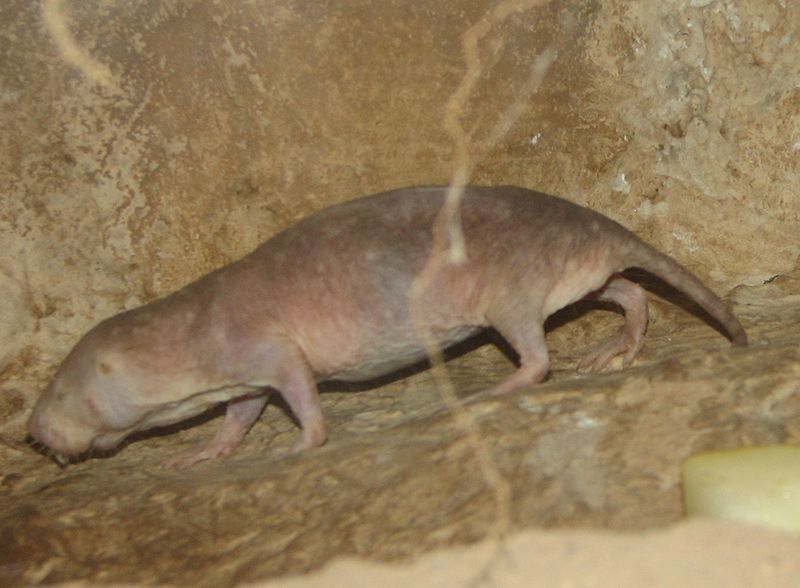Naked Mole Rat
Species Data
Class: Mammalia
Order: Rodentia
Family: Heterocephalidae
Scientific Name: Heterocephalus glaber
IUCN Red List status: Least Concern
Description
The Naked Mole Rat (Heterocephalus glaber), also known as the Sand Puppy, is a burrowing rodent native to parts of East Africa. Despite its name it is neither a mole nor a rat, being more closely related to porcupines and guinea pigs. They have no external ears and have tiny eyes, consequently they are virtually blind. Their sense of smell is important, and they are also very sensitive to vibrations in the ground and the movement of air currents.
The skin is wrinkly pink or greyish-pink on the underside and the tail is light purplish-brown. The head is short and broad and the jaw muscles are extremely powerful, as are the large incisors which they use for digging tunnels and in self-defence.
Naked Mole Rats are one of only two mammal species that are eusocial animals (the other is the Damaraland Mole Rat). This means they live in colonies that have overlapping generations, division of labour, and cooperative brood care, as in insect colonies.
Behaviour
A colony of Naked Mole Rats has a caste system with one female (called a queen) and one to three males (called soldiers); the rest of the rats are sterile workers. The queen and soldiers breed at about one year old and the queen and males maintain a relationship for several years. Gestation is about 70 days, after which the queen produces between 3 and 29 pups. She nurses them for a month after which they are fed by smaller workers until they are able to eat solid food. Larger workers maintain the nest and guard the colony from attacks. They can live to over 30 years, whereas a mouse’s lifespan is usually around 4 years.
They grow to about 3 in (7.5 cm) long, and weigh 1-1.5 ounces (28-42 gms). However, soldiers weigh more and the queen is the largest member of the colony, weighing up to 2.5 ounces (71 gms).


Habitat
Naked Mole Rats live exclusively in dry, desert habitats in East Africa and are found predominately in Somalia, Ethiopia, and Kenya, close to the equator. They are burrowing rodents feeding mainly on roots and tubers of plants that grow in these arid areas. They obtain all the water they need through their food; they do not drink.
Their tunnel system can be up to three miles in length, and consists of a number of chambers which have different uses – one for storing food, another as a toilet and one which acts as a mole rat nursery. If a predator enters the colony’s tunnels (such as a snake), the worker Naked Mole Rats will quickly raise alarms, notifying the soldier Naked Mole Rats, who will come and defend the colony. The defensive tactic they use is unique – they climb on top of each other, creating a vertical column displaying their large and sharp teeth. The predator initially just sees several gnashing teeth which act as a good deterrent. The soldiers synchronize their attacks and repeatedly bite the predator.
Threats and Conservation
IUCN classifies the Naked Mole Rat as Least Concern, as they are numerous within their range and consequently not considered to be endangered. They are sometimes persecuted by farmers where their underground tunnels spread under crops and they eat the roots. So if colonies are wiped out in such a way this would cause significant fall in numbers. Sometimes predators will enter the colony’s tunnels (for example, a snake), when the worker Naked Mole Rats will quickly raise alarms, notifying the soldier Naked Mole Rats. The soldiers then come defend the colony.
